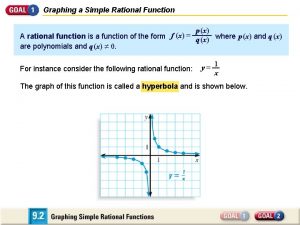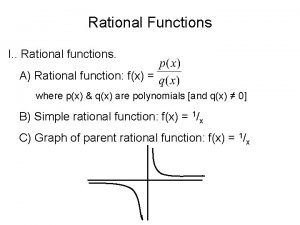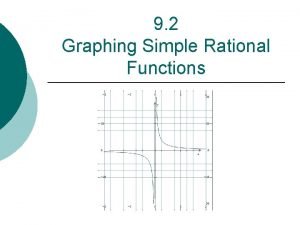Graphing Rational Functions What is a rational function
















- Slides: 16

Graphing Rational Functions

What is a rational function? or

Creating the graph 1. Put a vertical asymptote through the nonremovable zeros of the denominator. (note: removable discontinuities get covered in calculus) 2. Plot any horizontal or slant asymptotes. 3. Plot as many points as needed between and beyond asymptotes to determine the shape of the graph. 4. Sketch the curve.

Plotting points beyond and between asymptotes • It will work to pick any number you want between and beyond asymptotes. A superior student will include the x and y intercepts • x intercepts occur where y=0. For rational expressions this is where the numerator equals zero. • y intercepts occur where x = 0. Just plug in a zero.

Plot any vertical asymptotes • Remember that division by zero is not allowed. • Put a vertical asymptote through any number that makes the denominator (bottom) zero. You can think of it as a fence that says “Don’t go here. ” • Advanced: If a factor in the denominator can be canceled, it’s called a “removable discontinuity. ” You mark it with a hole in the graph rather than an asymptote.

Plot any horizontal or slant asymptotes • Compare the degrees of the numerator (n) and the denominator (m). • If n < m, you have the x-axis for a horizontal asymptote. • If n = m, you have a horizontal asymptote that is a fraction of the leading coefficients. • If n = m + 1, then you use long division to find the slant asymptote.

Example 1, step 1 Put a vertical asymptote through the zeros of the denominator. In this example, the denominator is zero when x = -1

Example 1, step 2 n=0 m=1 Since the degree in the numerator is smaller, the graph has a horizontal asymptote on the xaxis Compare the degrees of the numerator and denominator. Use the chart to decide which type of asymptote (if any) you have.

Example 1, step 3 Plot as many additional points as needed to determine the shape of the graph. We need one point to either side of x = -1 to decide which way the graph will go. Let’s use x = 0 and -2

Example 1, step 4 Now we sketch the curve.

Example 2 1. Find the vertical asymptote. 2. Find the slant/horizontal asymptote 3. Find the intercepts. 4. Find a point on the right side 5. Sketch the curve (0, -4) and (-3, 0) x =2 gives y = 20 which is off the graph but tells us which way it goes

Example 3 1. Graph the vertical asymptote x=2

Example 3 continued 2. Since the degree in the numerator is 1 higher than the degree in the bottom (n = m + 1), we use long division to find a slant asymptote. The top will always be a y = mx + b equation. Discard the remainder.

Example 3 continued 3. Find the x and y intercepts. You will need to factor the numerator to find (0, 10), (-5, 0), (4, 0) the x-intercepts. 4. Draw

Example 4 1. Find the vertical asymptotes. 2. Find the horizontal/slant asymptote 3. Find the intercepts. 4. Plot extra points to determine the shape of the graph. You will need one on each side of the asymptotes as well as between the asymptotes and intercepts. Choose x = 1, -1, 3, -3 5. Sketch.

Example 5 (last one) 1. Find the vertical asymptotes. 2. Find the horizontal/slant asymptotes. 3. Plot your intercepts. 4. Plot as many extra points as needed between and beyond asymptotes. Choose x = 1, -1, 4, and -4 5. Sketch.
 Rational function graph in real life
Rational function graph in real life Algebra 2b unit 4 trigonometric functions
Algebra 2b unit 4 trigonometric functions Graphing rational functions quiz
Graphing rational functions quiz Graphing rational functions
Graphing rational functions Graphing rational functions
Graphing rational functions Glue a picture for each greeting below
Glue a picture for each greeting below Domain and range of rational function
Domain and range of rational function Rational functions parent function
Rational functions parent function Parent function of hyperbola
Parent function of hyperbola Constant parent function equation
Constant parent function equation Rational fucntion
Rational fucntion 7-1 graphing exponential functions
7-1 graphing exponential functions Unit 5 polynomial functions answer key
Unit 5 polynomial functions answer key 12-7 graphing trigonometric functions answers
12-7 graphing trigonometric functions answers Graphing sine and cosine quiz
Graphing sine and cosine quiz Lesson 8-1 transformations of functions
Lesson 8-1 transformations of functions What is the coefficient in polynomials
What is the coefficient in polynomials































